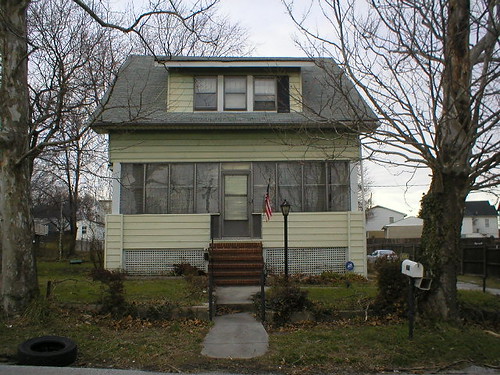So, I mutter unconvincingly that our house is a mutt – a mongrel house, like an American Shorthair cat or something, a breed that only exists so people would have something to call stripey farm cats. And yes, by the way, my cat is one. Just like my house.
I brought up the issue to Don, and he looked at me like I was an idiot. “It’s a cape cod,” he said witheringly.
“It is? How do you know?” I asked, in awe of his house-identifying skills.
There was a pause. “It just is,” he said. “It’s got, you know, an angled roof and the windows…” He trailed off, and then went back to playing online poker as if the matter were settled. Clearly, I was on my own.
First I checked the Maryland Department of Assessments and Taxation’s Real Property Search database to see if our tax assessment listed the type of house. It didn’t. Square footage, property size, ownership records, year of construction, ownership type and various other things, but not architectural style. So. Time for learning.
Wikipedia (my favorite resource -- it totally got me through my senior year of college) offers a list of house types with links to their corresponding articles. They also have a list of ‘house styles’ which is pretty much the same thing but a little longer and without any definitions, just links. This photo directory is a little more helpful, though it doesn’t have as great a selection. About.com’s index is useful, too. So, a quick primer later, I’m a lot more familiar with most of the standard architectural styles now, and I’m ready to ponder my own house.
The end result? I’m still not sure. It’s too tall to be a bungalow, too short to be an American foursquare, has too many sticky-outy bits to be a cape cod and not enough to be a colonial. Whatever it is, though, it’s in good company: almost every house of a certain age here on the southwest side of Baltimore looks exactly the same. I guess they’re all mutts.


7 comments:
That's a Cape Cod, no doubt about it. Because, um... uh... because it is!
I think it's an American Shorthair. Maybe it would be easier to classify if you visualize it without the porch enclosure - you know, with the wide porch and front window it originally had.
I looked at pictures in some of those sites. It isn't a Cape Cod. It doesn't have a steep roof, and has dormers and a porch. I'm pretty sure it is a Bungalow, more precisely, a California Bungalow. "California Bungalows, commonly called simply bungalows in America, are a form of residential structure that were widely popular across America and, to some extent, the world around the years 1910 to 1925" The pictures look just like your house, with the porch opened up, and the time of building is right
OK - this was obsessive. I'm stuck in a hotel room of non-descript architecture.
It's a bungalow, of some variety.
Hmm I love the idea behind this website, very unique.
»
Great site loved it alot, will come back and visit again.
»
I have been reading through looking at your blog and found it quite interesting. Your house is most definately a bungalow, though perhaps not a California Bungalow. I'm going to guess it was built between 1910-1930. The house was most likely a catalog house. Rather than having a developer sell lots with houses, they most likely sold lots to owners who then had a bulder construct the house they wanted. These catalog houses provided the perfect solution.
The siding appears to be vinyl or aluminum. You may prepahs find asbestos siding under that, but the original siding could very well have been cedar shake siding.
There is no doubt the porch was once open, providing a perfect place to enjoy the cool shade in the evening, as well as a place to stad out of the rain when trying to enter your front door.
Here is a website about the sears catalog houses:
http://architecture.about.com/gi/dynamic/offsite.htm?zi=1/XJ&sdn=architecture&zu=http%3A%2F%2Fwww.searsarchives.com%2F
Enjoy!
Harry
Baltimore,MD
Post a Comment